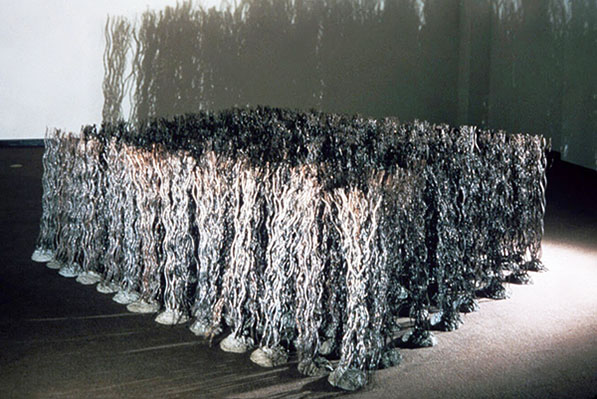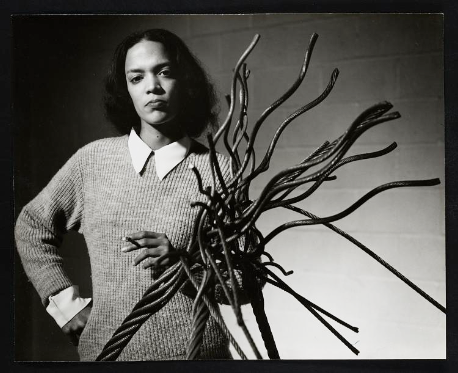마렌 해싱거(Maren Hassinger) DIA 비컨 설치작 'Field' 전시
업스테이트 뉴욕의 현대미술관 디아 비컨(Dia Beacon)이 12월 16일부터 흑인여성 조각가 마렌 해싱거(Maren Hassinger, 77)의 로프 설치작 'Field'(1983)을 전시한다. 마렌 해싱거는 1947년 LA에서 태어나 버몬트주 베닝턴칼리지에서 조각, 캘리포니아대(LA)에서 섬유구조학으로 석사학위를 받았다. 대학원 시절 폐차장에서 발견한 와이어 로프를 비롯 나뭇가지, 비닐봉지, 신문 등 대량 생산재료를 사용해 자연과 인류의 관계를 탐구해왔다.
Room-Size Installation by Maren Hassinger to be Presented on Long-Term View at Dia Beacon

Maren Hassinger, Field, 1983. Installation view, Los Angeles Southwest College Art Gallery, 1983. © Maren Hassinger and Susan Inglett Gallery, NYC. Photo courtesy the artist and Susan Inglett Gallery
Beacon, New York, December 15, 2023 – Opening on December 16, 2023, this presentation at Dia Beacon reveals Maren Hassinger’s multipart wire-rope installation Field (1983) in its expanded form for the very first time.
“Maren Hassinger’s work powerfully articulates the tenuous relationship between nature and humanity. In 2021, a yearlong presentation of Hassinger’s work at Dia Bridgehampton included a new bush sculpture, displayed outside the gallery space, as well as an installation indoors that reworked documentation of the 1991 piece Circles of Bushes. I am thrilled that this exhibition will once again spotlight her investigations with wire rope as a material and its allusions to humanity’s impact on the natural world,” said Jessica Morgan, Dia’s Nathalie de Gunzburg Director.
Spanning over five decades, Hassinger’s practice frequently blurs the boundaries between performance, sculpture, fiber arts, and installation. The artist’s signature use of industrial wire rope began in the 1970s, while pursuing her master’s degree in fiber structure at the University of California, Los Angeles, when she encountered the material in a junkyard. Since then, she has consistently manipulated the material to both physically and conceptually tease out its organic attributes.
Now at Dia Beacon, exhibited for the first time in nearly 40 years and in its never-before-seen entirety of 182 components, Field (1983) exemplifies Hassinger’s central formal and conceptual concerns. Comprised of wire-rope bundles meticulously unraveled to resemble feathered metal stalks planted in cement bases, the piece evokes, in the artist’s words, an “industrial field” where human-made products emulate nature in its absence, beckoning a reconsideration of one’s relationship with organic forms across both natural and built environments.
“Maren Hassinger considers her materials as active and responsive agents that suggest movement. Field demonstrates the artist’s perception of the viewer’s bodily navigation around the work as an extension of this embodied choreography, as well as her interest in our relationship with nature—its absence, erasure, and enduring power. Seen in the context of other artists associated with Postminimalism on view at Dia Beacon—such as Senga Nengudi, Fred Sandback, and Robert Smithson, among others—Hassinger enriches our understanding of process-oriented work and the expansive possibilities of a limited range of materials,” said Jordan Carter, curator and co–department head.
Maren Hassinger is organized by Jordan Carter, curator and co–department head, with Zuna Maza, curatorial assistant.
All exhibitions at Dia are made possible by the Economou Exhibition Fund.
Maren Hassinger is made possible by support from the Kaleta A. Doolin Foundation and James L. Cahn and Jeremiah J. Collatz.

Maren Hassinger, 1973
“I wanted my work to be an overarching statement about the nature of our lives now.”
-Maren Hassinger-
About Maren Hassinger
Maren Hassinger was born in Los Angeles in 1947. She received a BA in sculpture from Bennington College, Vermont, in 1969, and an MFA in fiber structure from the University of California, Los Angeles, in 1973. Often making use of both organic and mass-produced materials—including branches, plastic bags, newspapers, and wire rope—Hassinger’s work engages with the natural environment and its intersections with issues related to humanity. In the 1970s Hassinger was involved with Studio Z, a loose collective of artists that included Houston Conwill, David Hammons, and Senga Nengudi, among others. She has had solo exhibitions and projects at numerous institutions, including the Art Institute of Chicago; Aspen Art Museum, Colorado; Baltimore Museum of Art; Boca Raton Museum of Art, Florida; Socrates Sculpture Park, Queens; and Spelman College Museum of Fine Art, Atlanta. In 2021, the artist presented Maren Hassinger at Dia Bridgehampton, where she created a series of fabric panels printed with her work Circles of Bushes (1991) and two new bush sculptures on the outside grounds. Hassinger was a lecturer in the Department of Art at Stony Brook Southampton, New York, from 1992 to 1997; and served as Director of the Rinehart School of Sculpture, Maryland Institute College of Art, Baltimore, from 1997 to 2018. Hassinger lives in New York.
About Dia Art Foundation
Taking its name from the Greek word meaning “through,” Dia was established in 1974 with the mission to serve as a conduit for artists to realize ambitious new projects, unmediated by overt interpretation and uncurbed by the limitations of more traditional museums and galleries. Dia’s programming fosters contemplative and sustained consideration of a single artist’s body of work and its collection is distinguished by the deep and long-standing relationships that the nonprofit has cultivated with artists whose work came to prominence particularly in the 1960s and ’70s.
In addition to Dia Beacon, Dia Bridgehampton, and Dia Chelsea, Dia maintains and operates a constellation of commissions, long-term installations, and site-specific projects, notably focused on Land art, nationally and internationally. These include:
Walter De Maria’s The New York Earth Room (1977) and The Broken Kilometer (1979), Max Neuhaus’s Times Square (1977), and Joseph Beuys’s 7000 Eichen (7000 Oaks, inaugurated in 1982 and ongoing), all located in New York
De Maria’s The Lightning Field (1977), in western New Mexico
Robert Smithson’s Spiral Jetty (1970), in the Great Salt Lake, Utah
Nancy Holt’s Sun Tunnels (1973–76), in the Great Basin Desert, Utah
De Maria’s The Vertical Earth Kilometer (1977), in Kassel, Germany
Cameron Rowland’s Depreciation (2018)
Dia Beacon
3 Beekman Street
Beacon, New York
https://www.diaart.org
*Dia: Beacon: 허드슨강변의 첼시, 미니멀리즘의 메카




 [신간] 임플란트 함부로 하지 말아야 할 이유, 김광수 저
[신간] 임플란트 함부로 하지 말아야 할 이유, 김광수 저
 메트로폴리탄 뮤지엄 캄보디아(14점), 태국(2점) 유물 반환
메트로폴리탄 뮤지엄 캄보디아(14점), 태국(2점) 유물 반환

